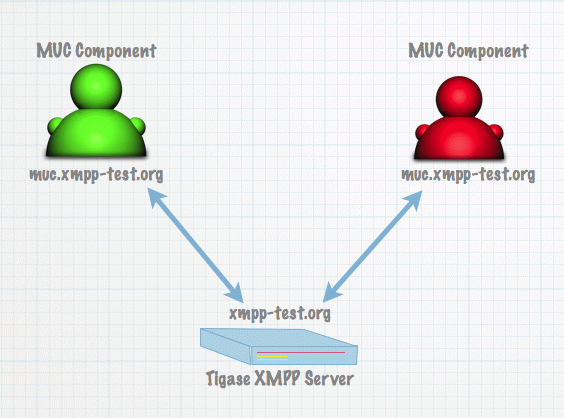The first, and most simple scenario is to connect multiple instances of an external component to a single Tigase XMPP Server to distribute load.
There are at least 2 reasons why this would be an optimal solution: one would be to spread load over more instances/machines and the second is to improve reliability in case one component fails the other one can take over the work.
So here is a simple picture showing the use case.

We have a single machine running Tigase XMPP Server and 2 instances of the MUC component connecting to Tigase.
On the server side we will enable ComponentProtocol component as we need to do to enable external component without clustering support.
Then using Admin UI we will add a new external component connection settings using Add item position for ext component in Configuration section of the web page just as it is described in External Component Configuration section.

The only change here is that we will specify value for field Load balancer class and we will use ReceiverBareJidLB as a value.
The configuration for both instances of the MUC component (identical for both of them) can be done in the same way as it is done for a single instance of the MUC component. There is nothing to change here.
The difference is one small element in the server configuration. At the value of Load balancer class field in Add item form is set to ReceiverBareJidLB.
This is the load balancing plugin class. Load balancing plugin decides how the traffic is distributed among different component connections that is different component instances. For the MUC component it makes sense to distribute the traffic based on the receiver bare JID because this is the MUC room address. This way we just distribute MUC rooms and traffic over different MUC component instances.
This distribution strategy does not always work for all possible components however. For transports for example this would not work at all. A better way to spread load for transports would be based on the source bare JID. And it is possible if you use plugin with class name: SenderBareJidLB.
This are two basic load distribution strategies available now. For some use cases none of them is good enough. If you have PubSub, then you probably want to distribute load based on the PubSub node. There is no plugin for that yet but it is easy enough to write one and put the class name in configuration.

